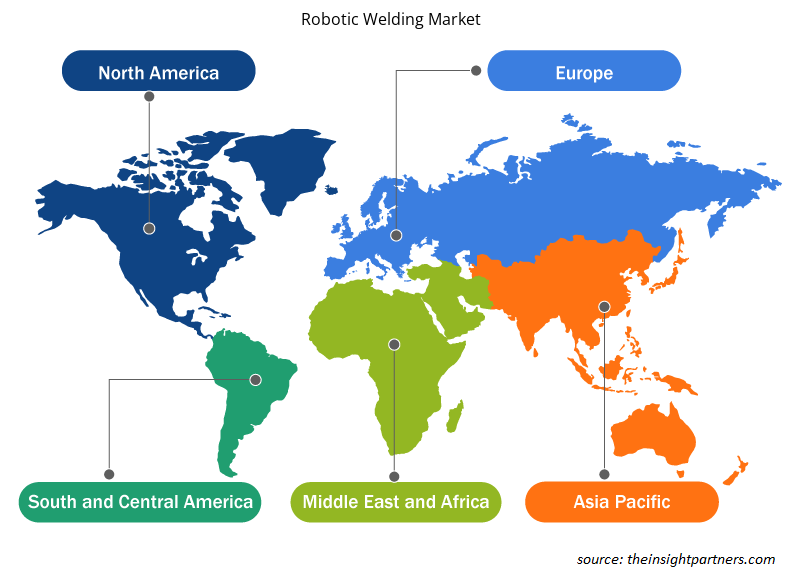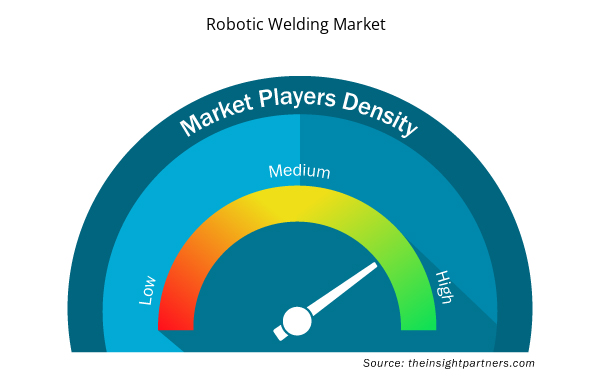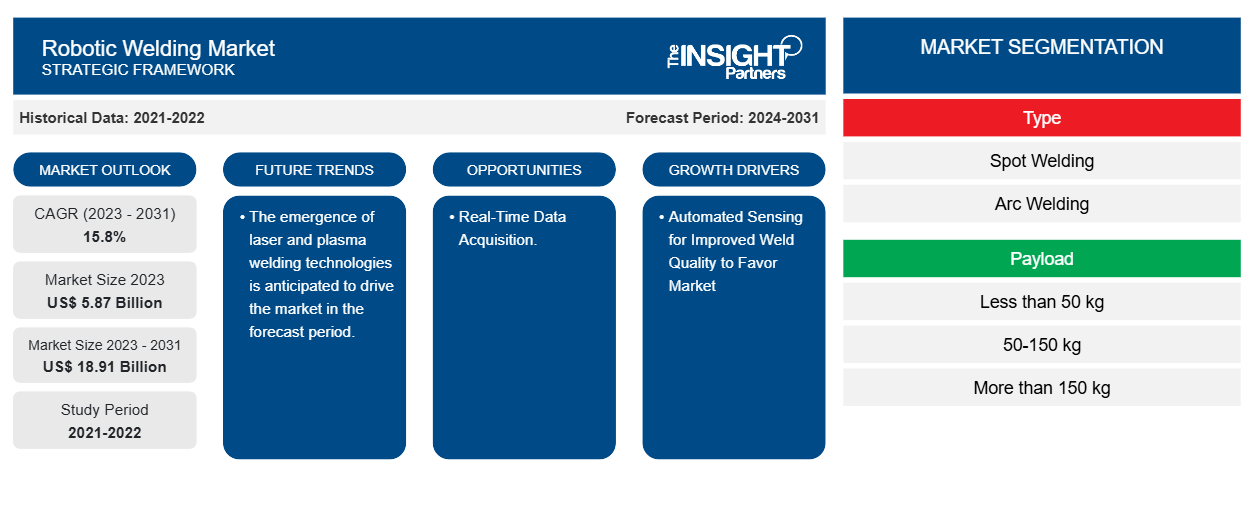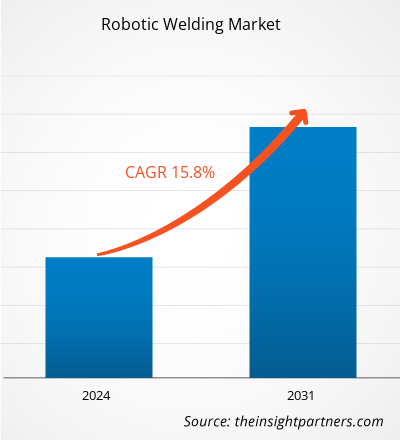Der Markt für Roboterschweißen soll von 5,87 Milliarden US-Dollar im Jahr 2023 auf 18,91 Milliarden US-Dollar im Jahr 2031 anwachsen. Der Markt wird zwischen 2023 und 2031 voraussichtlich eine durchschnittliche jährliche Wachstumsrate von 15,8 % verzeichnen. Industrie 4.0 als Wachstumsmotor für die Nachfrage nach Industrierobotern und die zunehmende Verbreitung von Schweißrobotern in der Automobilindustrie dürften die wichtigsten Treiber und Trends des Marktes sein.
Roboterschweißen Marktanalyse
Der Markt für Roboterschweißen verzeichnet weltweit ein starkes Wachstum. Dieses Wachstum ist auf die Industrie 4.0 zurückzuführen, die die Nachfrage nach Industrierobotern ankurbelt, sowie auf die zunehmende Verbreitung von Schweißrobotern in der Automobilindustrie. Darüber hinaus sind die staatlichen Initiativen zur Unterstützung der digitalen Transformation in der Region Asien-Pazifik und die Entstehung von Laser- und Plasmaschweißtechnologien weitere Faktoren, die das Wachstum des Marktes für Roboterschweißen fördern.
Marktübersicht für Roboterschweißen
Roboterschweißen ist eine Methode, die dem Industriesektor hilft, seine Prozesse zu automatisieren, die Genauigkeit zu erhöhen, die Vorlaufzeit zu verkürzen und die Sicherheit zu verbessern. Das Roboterschweißverfahren gilt als das produktivste Verfahren, wenn es für großvolumige und sich wiederholende Aufgaben eingesetzt wird. Es gibt mehrere Arten von Roboterschweißverfahren.
Passen Sie diesen Bericht Ihren Anforderungen an
Sie erhalten kostenlos individuelle Anpassungen an jedem Bericht, einschließlich Teilen dieses Berichts oder einer Analyse auf Länderebene, eines Excel-Datenpakets sowie tolle Angebote und Rabatte für Start-ups und Universitäten.
- Holen Sie sich die wichtigsten Markttrends aus diesem Bericht.Dieses KOSTENLOSE Beispiel umfasst eine Datenanalyse von Markttrends bis hin zu Schätzungen und Prognosen.
Treiber und Chancen auf dem Markt für Roboterschweißen
Automatisierte Sensorik für verbesserte Schweißqualität kommt dem Markt zugute
Automatisierte Sensortechnologien ermöglichen es Schweißrobotern, Vorgänge entsprechend den individuellen Werkstückabmessungen anzupassen. Dies verbessert die Qualität jeder Schweißnaht, erhöht die Arbeitsgeschwindigkeit und sorgt infolgedessen für einen höheren Durchsatz. Die Integration dieser Technologien in jede Schweißzelle hilft dabei, den Schweißvorgang zu überwachen und die Details für eine kontinuierliche Prozessoptimierung aufzuzeichnen, die Parameter des Schweißroboters automatisch entsprechend dem Werkstück anzupassen, den Schweißvorgang zu überwachen und die Details für eine kontinuierliche Prozessoptimierung aufzuzeichnen.
Echtzeit-Datenerfassung
Neben der automatischen Sensorik schreitet auch die Erfassung und Analyse von Betriebsdaten von Roboterschweißsystemen rasant voran. Da jede Schweißnaht einer spezifischen Prüfung bedarf, um den Qualitätskontrollprozess zu qualifizieren, ermöglichen diese Werkzeuge die Überprüfung der Verbindungsfestigkeit, der Dichtheit jeder Naht und der Schweißdurchdringung während des Schweißvorgangs.
Lichtbogenverfolgungs-Kontrollsysteme können Fehler automatisch erkennen und den Schweißvorgang korrigieren, um Nacharbeiten zu minimieren, die normalerweise erst bei einer zweiten Prüfung ans Licht kommen. Darüber hinaus ermöglichen diese Systeme die Messung von Nahtbreite und -profil während des Schweißvorgangs, die Erkennung von Nahtkanten und die Verfolgung der Nahtdurchdringung während des Schweißens, wodurch die Schweißdurchdringung gemäß den Spezifikationen gesteuert wird.
Segmentierungsanalyse des Marktberichts zum Roboterschweißen
Wichtige Segmente, die zur Ableitung der Marktanalyse für Roboterschweißen beigetragen haben, sind Typ, Nutzlast und Endbenutzer.
- Der Markt für Roboterschweißen wird nach Typ in Punktschweißen, Lichtbogenschweißen und andere unterteilt. Das Segment der Energiemanagementkomponenten dürfte im Prognosezeitraum einen erheblichen Marktanteil halten.
- Basierend auf der Nutzlast ist der Markt für Roboterschweißen in weniger als 50 kg, 50-150 kg und mehr als 150 kg unterteilt. Das Segment unter 50 kg wird im Prognosezeitraum voraussichtlich einen erheblichen Marktanteil halten.
- Nach Endverbraucher ist der Markt in die Bereiche Automobil und Transport, Elektrik und Elektronik, Metall und Maschinenbau sowie Bauwesen unterteilt. Es wird erwartet, dass die Bereiche Automobil und Transport im Prognosezeitraum einen erheblichen Marktanteil halten werden.
Roboterschweißen Marktanteilsanalyse nach Geografie
Der geografische Umfang des Marktberichts zum Roboterschweißen ist hauptsächlich in fünf Regionen unterteilt: Nordamerika, Asien-Pazifik, Europa, Naher Osten und Afrika sowie Süd- und Mittelamerika.
Nordamerika dominiert den Markt für Roboterschweißen. Der Trend hin zu hochtechnologischen Lösungen in verschiedenen Branchen in Nordamerika hat das Wachstum des Marktes für Roboterschweißen vorangetrieben. Faktoren wie die zunehmende Nutzung digitaler Tools und hohe Technologieausgaben von Regierungsbehörden dürften das Wachstum des nordamerikanischen Marktes für Roboterschweißen vorantreiben. Darüber hinaus zwingt eine starke Betonung von Forschung und Entwicklung in den entwickelten Volkswirtschaften der USA und Kanadas die nordamerikanischen Akteure dazu, technologisch fortschrittliche Lösungen auf den Markt zu bringen. Darüber hinaus gibt es in den USA eine große Anzahl von Akteuren auf dem Markt für Roboterschweißen, die sich zunehmend auf die Entwicklung innovativer Lösungen konzentrieren. All diese Faktoren tragen zum Wachstum des Marktes für Roboterschweißen in der Region bei.
Regionale Einblicke in den Markt für Roboterschweißen
Die regionalen Trends und Faktoren, die den Markt für Roboterschweißen im gesamten Prognosezeitraum beeinflussen, wurden von den Analysten von Insight Partners ausführlich erläutert. In diesem Abschnitt werden auch die Marktsegmente und die Geografie für Roboterschweißen in Nordamerika, Europa, im asiatisch-pazifischen Raum, im Nahen Osten und Afrika sowie in Süd- und Mittelamerika erörtert.

- Erhalten Sie regionale Daten zum Roboterschweißmarkt
Umfang des Marktberichts zum Roboterschweißen
| Berichtsattribut | Details |
|---|---|
| Marktgröße im Jahr 2023 | 5,87 Milliarden US-Dollar |
| Marktgröße bis 2031 | 18,91 Milliarden US-Dollar |
| Globale CAGR (2023 - 2031) | 15,8 % |
| Historische Daten | 2021-2022 |
| Prognosezeitraum | 2024–2031 |
| Abgedeckte Segmente | Nach Typ
|
| Abgedeckte Regionen und Länder | Nordamerika
|
| Marktführer und wichtige Unternehmensprofile |
|
Marktdichte von Roboterschweißgeräten: Auswirkungen auf die Geschäftsdynamik verstehen
Der Markt für Roboterschweißen wächst rasant, angetrieben durch die steigende Nachfrage der Endnutzer aufgrund von Faktoren wie sich entwickelnden Verbraucherpräferenzen, technologischen Fortschritten und einem größeren Bewusstsein für die Vorteile des Produkts. Mit steigender Nachfrage erweitern Unternehmen ihr Angebot, entwickeln Innovationen, um die Bedürfnisse der Verbraucher zu erfüllen, und nutzen neue Trends, was das Marktwachstum weiter ankurbelt.
Die Marktteilnehmerdichte bezieht sich auf die Verteilung der Firmen oder Unternehmen, die in einem bestimmten Markt oder einer bestimmten Branche tätig sind. Sie gibt an, wie viele Wettbewerber (Marktteilnehmer) in einem bestimmten Marktraum im Verhältnis zu seiner Größe oder seinem gesamten Marktwert präsent sind.
Die wichtigsten auf dem Markt für Roboterschweißen tätigen Unternehmen sind:
- Panasonic Corporation
- Yaskawa Electric Corporation
- ABB
- Fanuc Corporation
- IGM ROBOTERSYSTEME
- Kawasaki Heavy Industries, Ltd
Haftungsausschluss : Die oben aufgeführten Unternehmen sind nicht in einer bestimmten Reihenfolge aufgeführt.

- Überblick über die wichtigsten Akteure auf dem Markt für Roboterschweißen
Nachrichten und aktuelle Entwicklungen zum Roboterschweißen
Der Markt für Roboterschweißen wird durch die Erhebung qualitativer und quantitativer Daten nach Primär- und Sekundärforschung bewertet, die wichtige Unternehmensveröffentlichungen, Verbandsdaten und Datenbanken umfasst. Nachfolgend sind einige der Entwicklungen auf dem Markt für Roboterschweißen aufgeführt:
- Kemppi hat ein neues Roboterschweißgerät auf den Markt gebracht: den AX MIG Welder. Wir stellen den Kemppi AX MIG Welder vor – ein leistungsstarkes Roboterschweißgerät mit nahtloser Integration, einer benutzerfreundlichen Schnittstelle und der neuesten Schweißtechnologie. Der AX MIG Welder wurde speziell für hochintensive, rund um die Uhr betriebene automatisierte Schweißumgebungen entwickelt. Mit 400 oder 500 A Leistung und einem Roboterdrahtvorschub ist er für schwierige Aufgaben und das Erreichen anspruchsvoller Produktionsziele ausgelegt. (Quelle: Kemppi-Unternehmenswebsite, April 2023)
- NS ARC, die größte Schweißdrahtmarke in Frauenbesitz in den USA, und CLOOS North America, ein Pionier der Roboterschweißtechnologie mit über 100 Jahren Erfahrung in der Branche, geben stolz ihre strategische Allianz bekannt. (Quelle: NS ARC Company Website, Juli 2024)
Marktbericht zum Roboterschweißen – Umfang und Ergebnisse
Der Bericht „Marktgröße und Prognose für Roboterschweißen (2021–2031)“ bietet eine detaillierte Analyse des Marktes, die die folgenden Bereiche abdeckt:
- Marktgröße und Prognose für Roboterschweißen auf globaler, regionaler und Länderebene für alle abgedeckten wichtigen Marktsegmente.
- Markttrends für Roboterschweißen sowie Marktdynamik wie treibende Faktoren, Einschränkungen und wichtige Chancen.
- Detaillierte PEST/Porters Five Forces- und SWOT-Analyse.
- Marktanalyse für Roboterschweißen, die wichtige Markttrends, globale und regionale Rahmenbedingungen, wichtige Akteure, Vorschriften und aktuelle Marktentwicklungen umfasst.
- Branchenlandschaft und Wettbewerbsanalyse, einschließlich Marktkonzentration, Heatmap-Analyse, prominenten Akteuren und aktuellen Entwicklungen auf dem Markt für Roboterschweißen.
- Detaillierte Firmenprofile.
- Historische Analyse (2 Jahre), Basisjahr, Prognose (7 Jahre) mit CAGR
- PEST- und SWOT-Analyse
- Marktgröße Wert/Volumen – Global, Regional, Land
- Branche und Wettbewerbsumfeld
- Excel-Datensatz


- Bioremediation Technology and Services Market
- Aerospace Forging Market
- Virtual Event Software Market
- Semiconductor Metrology and Inspection Market
- Precast Concrete Market
- Equipment Rental Software Market
- Vertical Farming Crops Market
- Small Molecule Drug Discovery Market
- Single Pair Ethernet Market
- Visualization and 3D Rendering Software Market

Report Coverage
Revenue forecast, Company Analysis, Industry landscape, Growth factors, and Trends

Segment Covered
This text is related
to segments covered.

Regional Scope
North America, Europe, Asia Pacific, Middle East & Africa, South & Central America

Country Scope
This text is related
to country scope.
Häufig gestellte Fragen
The expected CAGR of the robotic welding market is 15.8%.
The global robotic welding market is expected to reach US$ 18.91 billion by 2031.
The key players holding majority shares in the global robotic welding market are Panasonic Corporation, Yaskawa Electric Corporation, ABB, Fanuc Corporation, IGM Robotersysteme, Kawasaki Heavy Industries, Ltd, Kuka Ag, Nachi Fujikoshi Corp, Novarc Technology, OTC Daihen.
The emergence of laser and plasma welding technologies is anticipated to drive the market in the forecast period.
Industrial 4.0 to drive demand for industrial robots and increasing adoption of welding robots in automotive industries are some of the factors driving the robotic welding market.
North America is anticipated to dominate the robotic welding market in 2023.
Trends and growth analysis reports related to Electronics and Semiconductor : READ MORE..
The Insight Partners performs research in 4 major stages: Data Collection & Secondary Research, Primary Research, Data Analysis and Data Triangulation & Final Review.
- Data Collection and Secondary Research:
As a market research and consulting firm operating from a decade, we have published and advised several client across the globe. First step for any study will start with an assessment of currently available data and insights from existing reports. Further, historical and current market information is collected from Investor Presentations, Annual Reports, SEC Filings, etc., and other information related to company’s performance and market positioning are gathered from Paid Databases (Factiva, Hoovers, and Reuters) and various other publications available in public domain.
Several associations trade associates, technical forums, institutes, societies and organization are accessed to gain technical as well as market related insights through their publications such as research papers, blogs and press releases related to the studies are referred to get cues about the market. Further, white papers, journals, magazines, and other news articles published in last 3 years are scrutinized and analyzed to understand the current market trends.
- Primary Research:
The primarily interview analysis comprise of data obtained from industry participants interview and answers to survey questions gathered by in-house primary team.
For primary research, interviews are conducted with industry experts/CEOs/Marketing Managers/VPs/Subject Matter Experts from both demand and supply side to get a 360-degree view of the market. The primary team conducts several interviews based on the complexity of the markets to understand the various market trends and dynamics which makes research more credible and precise.
A typical research interview fulfils the following functions:
- Provides first-hand information on the market size, market trends, growth trends, competitive landscape, and outlook
- Validates and strengthens in-house secondary research findings
- Develops the analysis team’s expertise and market understanding
Primary research involves email interactions and telephone interviews for each market, category, segment, and sub-segment across geographies. The participants who typically take part in such a process include, but are not limited to:
- Industry participants: VPs, business development managers, market intelligence managers and national sales managers
- Outside experts: Valuation experts, research analysts and key opinion leaders specializing in the electronics and semiconductor industry.
Below is the breakup of our primary respondents by company, designation, and region:

Once we receive the confirmation from primary research sources or primary respondents, we finalize the base year market estimation and forecast the data as per the macroeconomic and microeconomic factors assessed during data collection.
- Data Analysis:
Once data is validated through both secondary as well as primary respondents, we finalize the market estimations by hypothesis formulation and factor analysis at regional and country level.
- Macro-Economic Factor Analysis:
We analyse macroeconomic indicators such the gross domestic product (GDP), increase in the demand for goods and services across industries, technological advancement, regional economic growth, governmental policies, the influence of COVID-19, PEST analysis, and other aspects. This analysis aids in setting benchmarks for various nations/regions and approximating market splits. Additionally, the general trend of the aforementioned components aid in determining the market's development possibilities.
- Country Level Data:
Various factors that are especially aligned to the country are taken into account to determine the market size for a certain area and country, including the presence of vendors, such as headquarters and offices, the country's GDP, demand patterns, and industry growth. To comprehend the market dynamics for the nation, a number of growth variables, inhibitors, application areas, and current market trends are researched. The aforementioned elements aid in determining the country's overall market's growth potential.
- Company Profile:
The “Table of Contents” is formulated by listing and analyzing more than 25 - 30 companies operating in the market ecosystem across geographies. However, we profile only 10 companies as a standard practice in our syndicate reports. These 10 companies comprise leading, emerging, and regional players. Nonetheless, our analysis is not restricted to the 10 listed companies, we also analyze other companies present in the market to develop a holistic view and understand the prevailing trends. The “Company Profiles” section in the report covers key facts, business description, products & services, financial information, SWOT analysis, and key developments. The financial information presented is extracted from the annual reports and official documents of the publicly listed companies. Upon collecting the information for the sections of respective companies, we verify them via various primary sources and then compile the data in respective company profiles. The company level information helps us in deriving the base number as well as in forecasting the market size.
- Developing Base Number:
Aggregation of sales statistics (2020-2022) and macro-economic factor, and other secondary and primary research insights are utilized to arrive at base number and related market shares for 2022. The data gaps are identified in this step and relevant market data is analyzed, collected from paid primary interviews or databases. On finalizing the base year market size, forecasts are developed on the basis of macro-economic, industry and market growth factors and company level analysis.
- Data Triangulation and Final Review:
The market findings and base year market size calculations are validated from supply as well as demand side. Demand side validations are based on macro-economic factor analysis and benchmarks for respective regions and countries. In case of supply side validations, revenues of major companies are estimated (in case not available) based on industry benchmark, approximate number of employees, product portfolio, and primary interviews revenues are gathered. Further revenue from target product/service segment is assessed to avoid overshooting of market statistics. In case of heavy deviations between supply and demand side values, all thes steps are repeated to achieve synchronization.
We follow an iterative model, wherein we share our research findings with Subject Matter Experts (SME’s) and Key Opinion Leaders (KOLs) until consensus view of the market is not formulated – this model negates any drastic deviation in the opinions of experts. Only validated and universally acceptable research findings are quoted in our reports.
We have important check points that we use to validate our research findings – which we call – data triangulation, where we validate the information, we generate from secondary sources with primary interviews and then we re-validate with our internal data bases and Subject matter experts. This comprehensive model enables us to deliver high quality, reliable data in shortest possible time.


 Holen Sie sich ein kostenloses Muster für diesen Bericht
Holen Sie sich ein kostenloses Muster für diesen Bericht